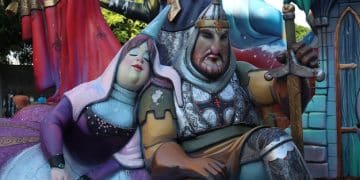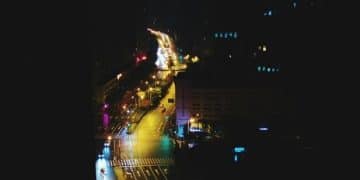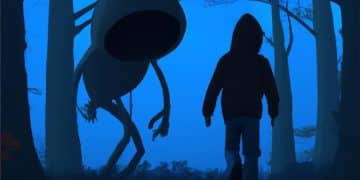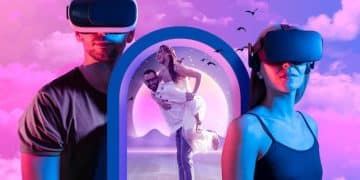Living Lore: How Subcultures in the US Reshape Storytelling
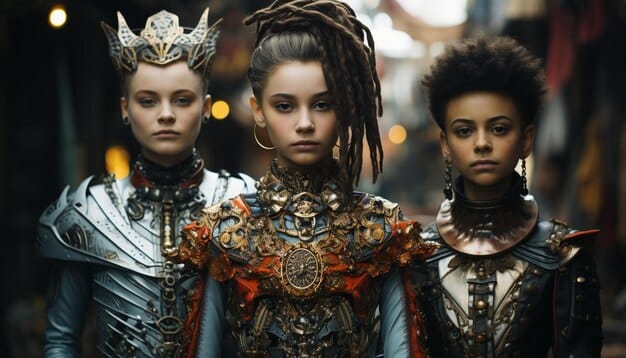
Living lore subcultures in the US, evolving beyond traditional cosplay, are significantly impacting storytelling by creating immersive, participatory narratives that blur the lines between fiction and reality.
Dive into the captivating world of living lore subcultures in the US, where enthusiasts are not just dressing up as characters but actively embodying and expanding upon beloved stories, changing the landscape of modern storytelling.
The Evolution Beyond Cosplay into Living Lore
Cosplay has long been embraced as a means of expressing fandom, but a new phenomenon is emerging: living lore. This evolution moves beyond merely replicating costumes and appearances, delving into a deeper engagement with the source material, transforming fans into active participants within the narrative landscape.
This shift signifies a more profound connection with the storytelling, where individuals not only portray characters but also contribute to the ongoing narrative through role-playing, world-building, and community events.
The Core Differences: Cosplay vs. Living Lore
While both cosplay and living lore involve dressing up as fictional characters, their approaches and goals differ significantly. Cosplay primarily focuses on accurate representation, whereas living lore emphasizes immersion and interaction within the fictional world.
- Cosplay: Focuses on visual representation and craftsmanship.
- Living Lore: Emphasizes immersive role-playing and narrative expansion.
- Cosplay: Often showcased at conventions and events for admiration.
- Living Lore: Involves ongoing engagement and creation within the fictional universe.
Living lore cultivates deeper bonds through shared experiences and creative contributions pushing the boundaries of traditional fan engagement. Therefore, it is much more transformative and profound than Cosplay.

The essence of living lore lies in the active role participants take in shaping and expanding the narratives they love. This immersive experience enriches the community and creates a unique cultural phenomenon.
Defining Characteristics of Living Lore Subcultures
Living lore subcultures aren’t just about dressing up; they involve a comprehensive immersion into a fictional world. Several characteristics define these vibrant communities.
These characteristics include deep knowledge of the source material, a commitment to authenticity, and an active role-playing environment that keeps the narrative alive and evolving.
Community-Driven Narrative Creation
One of the most significant aspects of living lore is the collaborative creation of narratives. Participants often develop their own storylines, characters, and histories within the established framework of the source material extending and personalizing the fictional universe.
- Interactive Storytelling: Participants engage in collaborative world-building and role-playing scenarios.
- Character Development: Creation of original characters that fit within the fictional world.
- Community Events: Organized gatherings that enhance the immersive experience.
- Artistic Expression: Crafting costumes, props, and lore-related art that deepens immersion.
The collaborative spirit of living lore communities fosters creativity and provides a platform for individuals to contribute meaningfully to the stories they cherish. It is about contributing to the story and personalizing it.
This collaborative environment allows the subculture to thrive, continually evolving with new ideas and interpretations. It is a testament to the creativity and passionate dedication of its members.
Historical Context and the Rise of Immersive Fandom
The growth of living lore subcultures can be seen as a natural progression of fandom, influenced by technological advancements, the rise of internet communities, and a desire for more profound engagement with storytelling.
This evolution involves understanding how social media platforms, online gaming, and participatory culture have fueled the rise of immersive fandom. Together, these factors have paved the way for living lore to flourish.
The Role of the Internet and Social Media
The internet has played a crucial role in connecting fans and facilitating the exchange of ideas, knowledge, and creative content. Therefore, social media platforms have become breeding grounds for immersive communities.
Online forums, social media groups, and dedicated websites provide spaces for fans to discuss lore, share creations, and organize events, strengthening the bonds within the subculture.

The internet has enabled living lore communities to transcend geographical boundaries, connecting fans from diverse backgrounds and creating a global network of enthusiasts.
Impact on Storytelling and Creative Industries
The emergence of living lore subcultures has a profound impact on storytelling and the creative industries as it represents a shift in how audiences engage with and contribute to narratives.
This impact includes influencing authors, game designers, and filmmakers to create more participatory and immersive experiences, recognizing the value of fan contributions and community engagement.
Influence on Authors and Game Designers
Authors and game designers are taking note of the passion and dedication of living lore communities, incorporating fan-driven elements into their works. This collaboration creates richer and more inclusive storytelling experiences.
- Participatory Storytelling: Integration of fan theories and creations into official lore.
- Immersive Experiences: Design of games and narratives that encourage active participation.
- Community Feedback: Usage of fan input to refine storylines and character development.
- Co-Creation: Partnership with fans in the ongoing expansion of the fictional universe.
This synergistic relationship between creators and fans fosters a more dynamic and responsive creative ecosystem, highlighting the importance of community input in shaping modern narratives.
Authors and game designers are adapting their strategies recognizing that fans are active participants.
Case Studies: Specific US-Based Living Lore Communities
Several US-based communities are a prime example of the living lore phenomenon, each with unique traits and approaches to immersing themselves in fictional worlds.
These communities encompass diverse fandoms, genres, and creative expressions representing the wide range of interests and passions that drive the living lore movement.
The Star Wars Expanded Universe: A Thriving Living Lore Community
The Star Wars Expanded Universe provides a great example of how fans engage in living lore, creating their own characters, stories, and interpretations within the established canon.
Fan-made films, role-playing groups, and online communities contribute to the ongoing expansion of the Star Wars universe, exemplifying the creativity and dedication of living lore enthusiasts.
Live Action Role Playing (LARP)
Another aspect comes through Live Action Role Playing (LARP), which combines elements of role-playing games with interactive performance art, creating fully immersive experiences. LARP events often recreate fictional worlds, inviting participants to step into character and engage in collaborative storytelling.
LARP communities exist across the US, each with unique themes and settings. They contribute significantly enriching individual fictional narratives.
These communities demonstrate the diverse ways in which US-based fans are engaging with living lore, showcasing the transformative power of immersive fandom.
The Future of Living Lore: Trends and Predictions
The future of living lore subcultures looks promising, with ongoing technological advancements, shifting cultural norms, and a growing desire for personalized storytelling experiences shaping the landscape. These trends point to a further integration of fans into the creative process and an increasing blurring of the lines between reality and fiction.
Predictions include emerging technologies could enhance immersive experiences, increase collaboration between creators and fans, and drive the evolution of living lore communities.
Augmented Reality (AR) and Virtual Reality (VR)
These technologies offer endless possibilities for immersive storytelling, enabling fans to step into their favorite fictional worlds and interact with characters and narratives in unprecedented ways. VR/AR integration will revolutionize living lore in the future.
- Immersive Simulations: Recreate fictional environments for fully immersive role-playing.
- Interactive Storytelling: Enable real-time decisions and actions that alter the narrative.
- Virtual Community Spaces: Facilitate global interaction and collaboration among fans.
- Enhanced Realism: Overlay digital elements onto the physical world to blur the lines between reality and fiction.
As AR and VR technologies become more accessible and affordable, they are poised to transform living lore into a deeply engaging and personalized experience.
In conclusion, continuous innovation and adaptation will be key to shaping a thriving and inclusive community.
| Key Point | Brief Description |
|---|---|
| 🎭 Defining Living Lore | Going beyond cosplay by immersing in a fictional world. |
| 🌐 Community Impact | Fosters creativity, shared storytelling, and belonging. |
| 🚀 Future Trends | AR/VR enhancing immersive and participatory experiences. |
| ⭐ Star Wars Example | Fan contributions expanding the universe via fan films, role-playing, etc. |
Frequently Asked Questions
▼
Living lore is more than just dressing up as characters. It’s about actively participating in, and contributing to, the narrative of a fictional world through role-playing, fan-made content, and community events.
▼
Cosplay primarily focuses on the accurate visual representation of characters. Living lore goes further, emphasizing immersive interactions within the fictional world, including narrative expansion and collaborative storytelling.
▼
The Internet provides a crucial platform for fans to connect, share ideas, and organize events, strengthening community bonds. Online forums and social media groups provide dedicated spaces for these interactions.
▼
Authors and game designers are starting to incorporate fan-driven elements into their works to create more participatory and inclusive storytelling experiences. This often involves integrating fan theories and feedback.
▼
Augmented Reality (AR) and Virtual Reality (VR) have the potential to revolutionize the experience by enabling fans to step into their favorite fictional worlds and interact in unprecedented immersive ways.
Conclusion
Living lore subcultures in the US represent a fascinating evolution of fandom, impacting storytelling and creating immersive experiences for enthusiasts. As technology continues to advance, we can expect even more innovative ways for fans to engage with their favorite fictional worlds.
